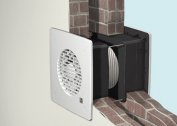Private houses require ventilation no less than urban high-rise buildings. Most widely used method ventilation in a private house - This is natural ventilation. It does not require additional energy costs, inexpensive and installation.
But not always cheap is the best. Natural supply or exhaust ventilation in a private house often gives malfunctions.
Private ventilation ducts and natural ventilation
Natural exhaust ventilation in a private house is a vertical ventilation ducts going from the room and ending above the roof of the house. Heated air from rooms is lighter than air on the street, so it rises into the atmosphere.
It is impossible to artificially affect the intensity of gas ventilation in a private house. But it is very dependent on weather conditions.
Natural ventilation in a private house is organized through windows or valves installed in the walls and windows. The intensity of the inflow is directly proportional to the intensity of the outflow. That is, if it is warm outside, then the system is practically inactive. Estimated air temperature for such systems are taken +5 degrees. The wind has a significant impact on traction.
Forced ventilation of a private house
The forced ventilation system in a private house works according to the inflow-blowing scheme. In this case, the heat recovered from the air is recovered. The system consists of several fans, a heat exchanger-heat exchanger, filters, and a control mechanism. Two ventilation ducts are mounted: for air flow and for supplying it to the mechanism. The exhaust air from the room is drawn and released into the atmosphere. Through another ventilation duct, clean air from the street is filtered, warmed up and sent to the room. In the cold season, both flows stay for some time in the recuperator, where warm air gives off the temperature to the cold. The presence of a gas ventilation recuperator in a private house allows you to save up to a quarter of the energy spent on heating the cottage.
If the owner wishes, the system is equipped with special filters, a humidifier or a dehumidifier, a cooler. That is, the parameters of the air entering the cottage are completely controlled by its residents. Operating modes are set and maintained automatically. You can make the ventilation system in a private house even more economical by installing a heat pump - the heat exchanger is buried in the ground and takes heat from it.



